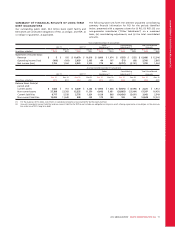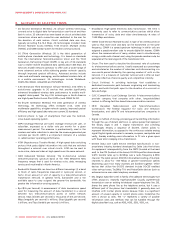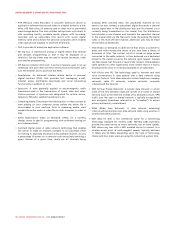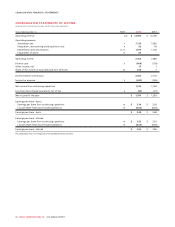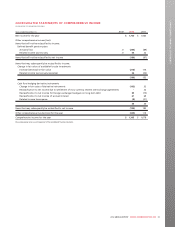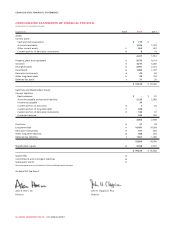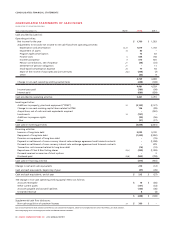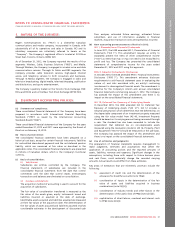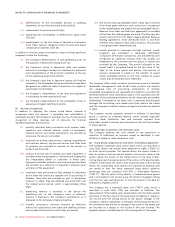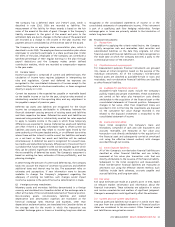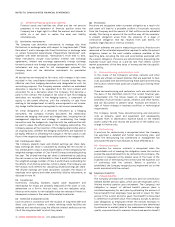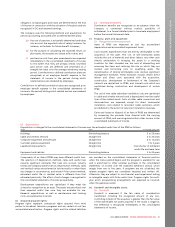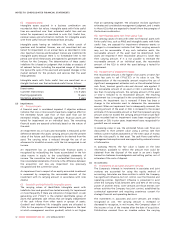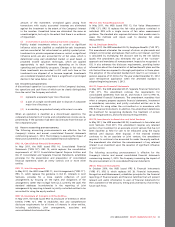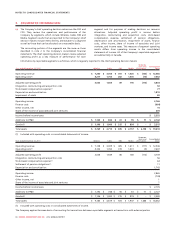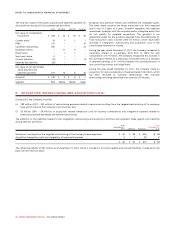Rogers 2012 Annual Report Download - page 91
Download and view the complete annual report
Please find page 91 of the 2012 Rogers annual report below. You can navigate through the pages in the report by either clicking on the pages listed below, or by using the keyword search tool below to find specific information within the annual report.
NOTES TO CONSOLIDATED FINANCIAL STATEMENTS
NOTES TO CONSOLIDATED FINANCIAL STATEMENTS
(TABULAR AMOUNTS IN MILLIONS OF CANADIAN DOLLARS, EXCEPT PER SHARE AMOUNTS)
1. NATURE OF THE BUSINESS:
Rogers Communications Inc. (“RCI”) is a diversified Canadian
communications and media company, incorporated in Canada, with
substantially all of its operations and sales in Canada. RCI and its
subsidiary companies are collectively referred to herein as the
“Company”. The Company’s registered office is located at 333 Bloor
Street East, Toronto, Ontario, M4W 1G9.
As of December 31, 2012, the Company reported the results of four
segments: Wireless, Cable, Business Solutions (“RBS”), and Media.
Through Wireless, the Company is engaged in wireless voice and data
communications services. Through its Cable and RBS segments, the
Company provides cable television services, high-speed Internet
access, and telephony services to both consumers and businesses.
Through its Media segment, the Company is engaged in radio and
television broadcasting, digital media, televised shopping, publication
and distribution, and sports entertainment.
The Company is publicly traded on the Toronto Stock Exchange (TSX:
RCI.a and RCI.b) and on the New York Stock Exchange (NYSE: RCI).
2. SIGNIFICANT ACCOUNTING POLICIES:
(a) Statement of compliance:
These consolidated financial statements of the Company have been
prepared in accordance with International Financial Reporting
Standards (“IFRS”) as issued by the International Accounting
Standards Board (“IASB”).
These consolidated financial statements of the Company for the years
ended December 31, 2012 and 2011 were approved by the Board of
Directors on February 14, 2013.
(b) Basis of presentation:
The consolidated financial statements have been prepared on a
historical cost basis, except for certain financial instruments, liabilities
for cash-settled share-based payments and the net deferred pension
liability, which are measured at fair value as described in the
applicable notes. The consolidated financial statements are presented
in millions of Canadian dollars, which is the Company’s functional
currency.
(c) Basis of consolidation:
(i) Subsidiaries:
Subsidiaries are entities controlled by the Company. The
financial statements of subsidiaries are included in the
consolidated financial statements from the date that control
commences until the date that control ceases. Intercompany
transactions and balances are eliminated on consolidation.
(ii) Business combinations:
The acquisition method of accounting is used to account for the
acquisition of subsidiaries.
The fair value of consideration transferred is measured as the
fair value of the assets given, equity instruments issued and
liabilities incurred or assumed at the date of exchange.
Identifiable assets acquired and liabilities assumed are measured
at their fair values at the acquisition date. The determination of
the fair values of assets acquired and liabilities assumed involves
considerable estimates in the development of discounted cash
flow analyses, estimated future earnings, estimated future
subscribers, and use of information available in financial
markets. Acquisition transaction costs are expensed as incurred.
(d) New accounting pronouncements effective in 2012:
IAS 1, Presentation of Financial Statements
In June 2011, the IASB amended IAS 1, Presentation of Financial
Statements (“IAS 1”). This amendment requires an entity to
separately present the items of other comprehensive income
(“OCI”) as items that may or may not need to be reclassified to
profit and loss. The Company has presented the consolidated
statements of comprehensive income for the years ended
December 31, 2012 and 2011 using this approach.
IFRS 7, Financial Instruments: Disclosures
In October 2010, the IASB amended IFRS 7, Financial Instruments:
Disclosures (“IFRS 7”). This amendment enhances disclosure
requirements to aid financial statement users in evaluating the
nature of, and risks associated with, an entity’s continuing
involvement in derecognized financial assets. The amendment is
effective for the Company’s interim and annual consolidated
financial statements commencing January 1, 2012. The Company
has assessed the impact of this amendment and there is no
impact on the consolidated financial statements.
IAS 12, Deferred Tax: Recovery of Underlying Assets
In December 2010, the IASB amended IAS 12, Deferred Tax:
Recovery of Underlying Assets (“IAS 12”). IAS 12 includes a
rebuttal presumption which determines that the deferred tax on
the depreciable component of an investment property measured
using the fair value model from IAS 40, Investment Property
should be based on its carrying amount being recovered through
a sale. The standard has also been amended to include the
requirement that deferred tax on non-depreciable assets
measured using the revaluation model in IAS 16, Property, Plant
and Equipment (“IAS 16”) should be measured on the sale basis.
The Company has assessed the impact of this amendment and
there is no impact on the consolidated financial statements.
(e) Use of estimates and judgments:
The preparation of financial statements requires management to
make judgments, estimates and assumptions that affect the
application of accounting policies and the reported amounts of
assets, liabilities, revenue and expenses. Significant changes in the
assumptions, including those with respect to future business plans
and cash flows, could materially change the recorded carrying
amounts. Actual results could differ from these estimates.
Key areas of estimation that are inherently uncertain include the
following:
(i) assessment of credit risk and the determination of the
allowance for doubtful accounts (note 19(a));
(ii) consideration of inputs in the determination of the fair
value of assets and liabilities acquired in business
combinations (note 2(c)(ii));
(iii) consideration of industry trends and other factors in the
determination of the useful lives of PP&E (note 2(r)(ii));
(iv) capitalization of direct labour, overhead and interest costs
to PP&E (note 2(r)(i));
2012 ANNUAL REPORT ROGERS COMMUNICATIONS INC. 87


